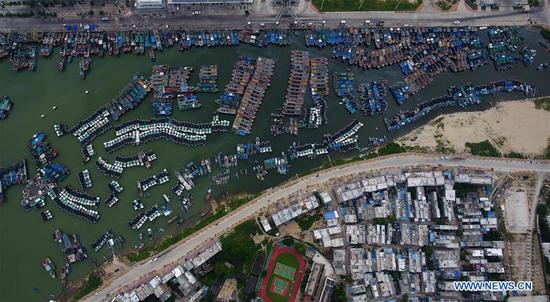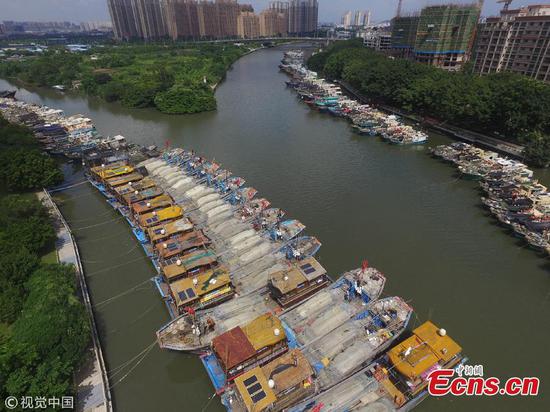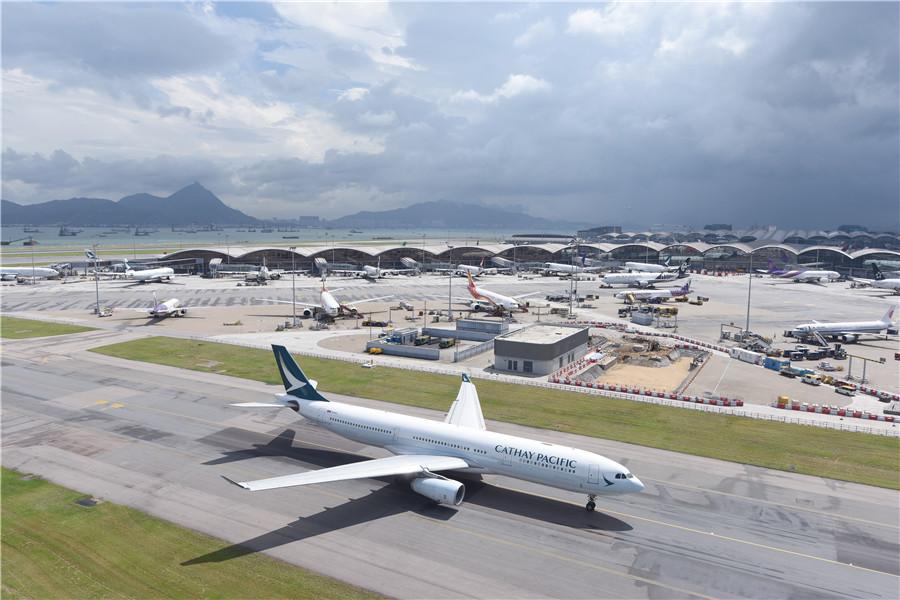
A jet taxies at Hong Kong International Airport at Chek Lap Kok in the New Territories. Last year, the airport had connections to 220 international destinations. More than 120 airlines operated there, handling 73.6 million passengers. PROVIDED TO CHINA DAILY
It was 6:30 a.m. on July 6, 1998, when a commercial airliner from New York made the first landing at the newly completed Hong Kong International Airport.
Only five hours before the inaugural flight landed at the new facility-Chek Lap Kok Airport-the final flight took off from Hong Kong's aging Kai Tak Airport. The runway lights at Kai Tak were switched off for the last time at 1:20 am that day.
The opening of the new airport built on reclaimed land on the island of Chek Lap Kok was a landmark event, contributing to Hong Kong's status in international aviation.
"That was the beginning of our steep climb, to rise and shine as one of the world's major aviation hubs," Hong Kong Special Administrative Region Chief Executive Carrie Lam Cheng Yuet-ngor said on the airport's 20th anniversary.
The statutory body overseeing the airport's operations, the Airport Authority Hong Kong, has noted the importance of the facility's location. Half the world's population lives within five hours' flying time of Chek Lap Kok.
The authority said the airport handled about 73 million passengers and more than 5 million metric tons of cargo in 2017, making it the world's eighth-busiest passenger airport, and the world's busiest for cargo.
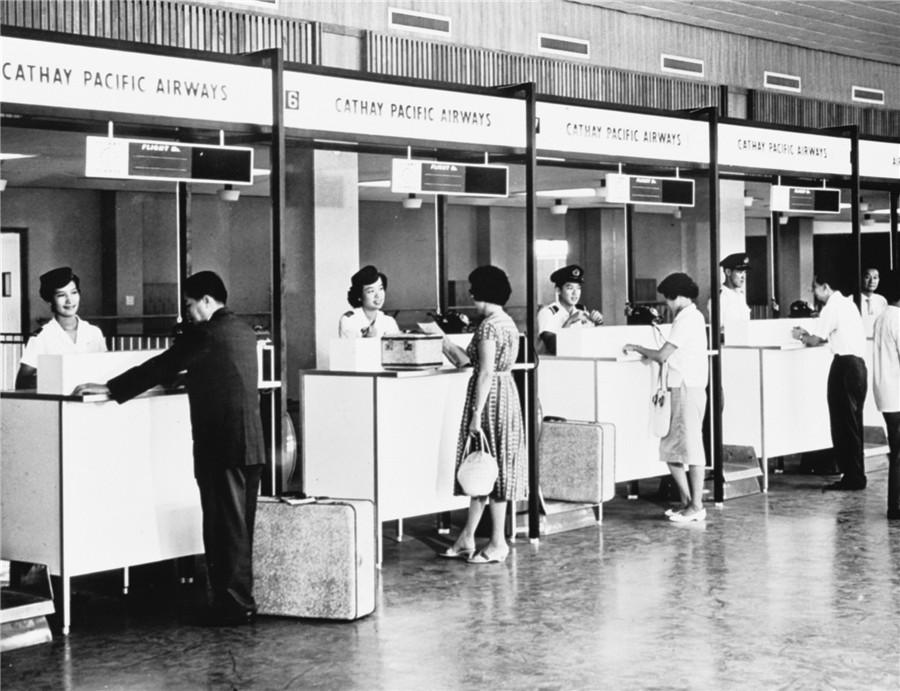
Cathay Pacific check-in desks at Kai Tak Airport in 1962. PHOTO PROVIDED TO CHINA DAILY
The airport was a long-awaited replacement for Kai Tak, considered by pilots as one of the most challenging airports in the world.
Pilots had to negotiate steep hills near Kai Tak, often buffeted by challenging crosswinds. The old airport was situated in heavily populated Kowloon City, with a single runway built on reclaimed land extending out to sea.
Kai Tak started to operate in 1930, becoming a key factor in Hong Kong's rise to prominence among international air destinations. By the 1960s, traffic had steadily increased, as Western airlines began to operate more flights to the Far East.
In 1993, Kai Tak handled 24.5 million passengers, surpassing its original design capacity. Three years later, it became the world's busiest cargo airport, handling 1.56 million tons, and the third-busiest international passenger airport, handling 29.5 million passengers.
By 1993, moves to replace overstretched Kai Tak were moving ahead. The government had announced its plan to build a new and larger airport in 1989. The new facility was destined for Chek Lap Kok, an island off Lantau Island, in the western part of Hong Kong.
Construction began in 1991. The new airport was to be served by nine additional facilities, including a high-speed rail system, a third cross-harbor tunnel linking Hong Kong Island and Kowloon, and the new town of Tung Chung.
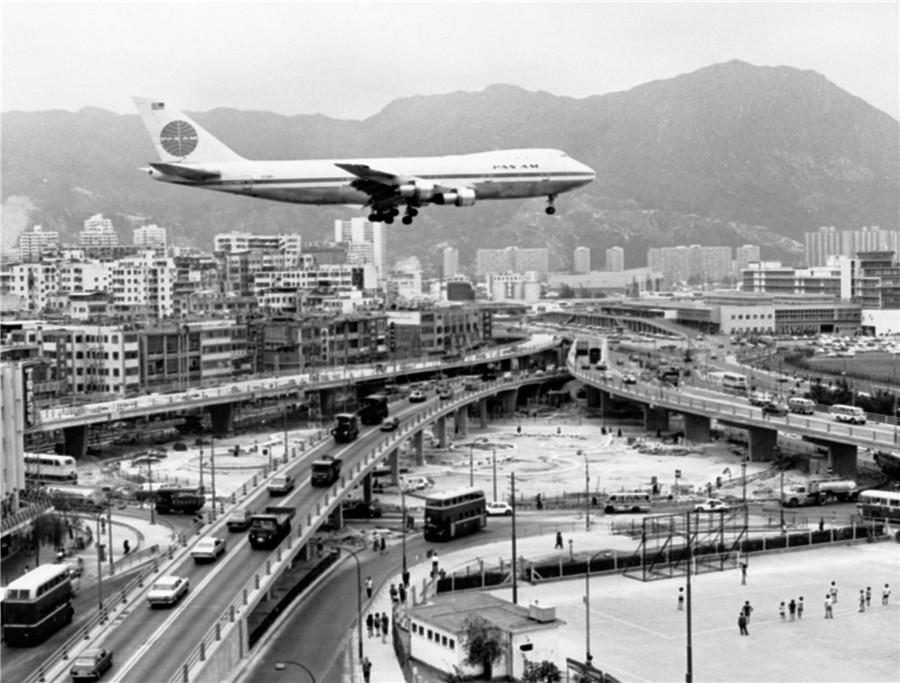
A plane prepares to land at Kai Tak Airport in 1972. PHOTO PROVIDED TO CHINA DAILY
Passenger surge
Sprawling across 1,255 hectares, the new airport is four times the size of Kai Tak. With the greater size came a surge in passenger volume and more extensive links to turn Hong Kong into a leading global aviation hub.
When the new airport began to operate, it handled about 21.6 million passengers, traveling to 120 global destinations on about 60 airlines.
Last year, it had connections to 220 international destinations. More than 120 airlines operated there, handling 73.6 million passengers.
"Chek Lap Kok airport is modern and spacious. In particular, I found that the services the airport provides are efficient and the staff are courteous," said Lau Chi-kuen, associate dean of the School of Communication at Hong Kong Baptist University, who uses the airport frequently.
Bunny Wong is one of the 3,000-plus staff members working at the airport. Serving as a duty officer for 10 years, he said Chek Lap Kok has been striving to provide the best services to local and global passengers.
He said that in 2008, four or five employees were assigned to daily patrols at each terminal. Now, the number has risen to nine in a bid to offer prompt and comprehensive services.
Wong works a 12-hour day. Besides answering passengers' inquiries and meeting their demands, he has to liaise and coordinate with different departments at the airport.
"Being tired is unavoidable. But I am happy with my job. And satisfied passengers always cheer me up," he said.
Chek Lap Kok has won 70"Best Airport" awards over the past 20 years.
Official data also show that the new airport played a part in attracting more than 7,500 multinational corporations to set up regional headquarters and offices in Hong Kong.
In August 2016, construction of a third runway began at the airport at an estimated cost of HK$141.5 billion ($18 billion). The airport had already reached its maximum capacity, handling 68 flights an hour at peak times.
The third runway, which is expected to be completed in 2024, will enable the airport to handle 26.4 million more passengers and an additional 4 million tons of cargo annually. It will generate HK$455 billion worth of additional economic benefits by 2061.
In June, the airport authority awarded Cainiao Network, an Alibaba Group logistics arm, the right to develop and manage a logistics center at the airport. The center is scheduled to begin operating in 2023.
In 2006, the airport authority established a joint venture to manage Zhuhai Airport in Guangdong province, under which it marketed the professional services available in Hong Kong. The next year, the authority signed an agreement to provide management and training support for the commissioning of Terminal 3 at Beijing Capital International Airport.
The authority's efforts in advancing Hong Kong's professional services intensified last year when the Hong Kong International Aviation Academy opened and began training its first students.
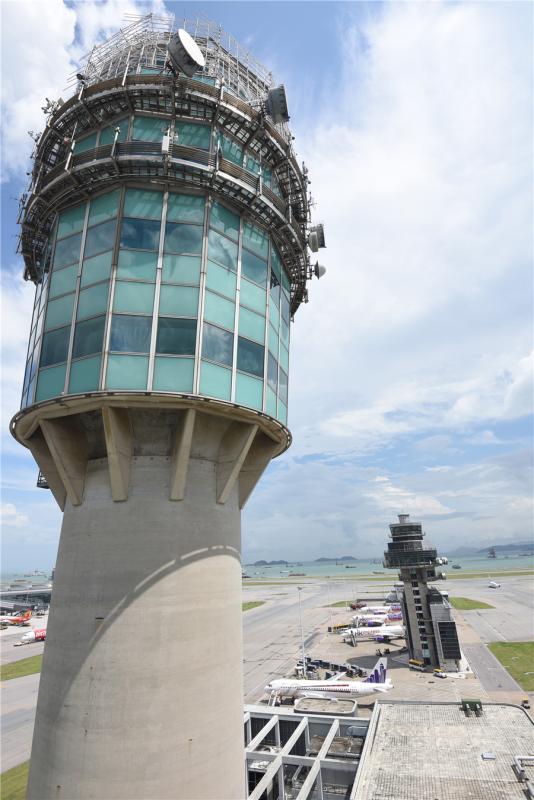
Hong Kong International Airport opened on July 6, 1998. PHOTO PROVIDED TO CHINA DAILY
New role in new era
"HKIA is in a strategic location to help the overall development of the Guangdong-Hong Kong-Macao Greater Bay Area, as it serves as the best choice for mainland Bay Area cities to connect with the world" said Ng Chi-kee, executive director of operations at the airport authority.
He referred to the "Framework Agreement on Deepening Guangdong-Hong Kong-Macao Greater Bay Area" which was signed by the National Development and Reform Commission, the Guangdong provincial government and Hong Kong and Macao Special Administrative Regions on July 1 last year.
The agreement states that Hong Kong should use its advantages as an international maritime center to drive the growth of other cities in the Bay Area, and build world-class port and airport clusters.
Ng attributes Chek Lap Kok's significant role in the Bay Area development to the airport's enviable location, its extensive international network, and most important, its connections with Bay Area cities.
To capitalize on the soon-to-open Hong Kong-Zhuhai-Macao Bridge, the airport plans to build a transfer terminal next to its SkyPier to provide shuttle bus services to locations in the Bay Area. The service will also be available to overseas passengers travelling to Zhuhai and Macao via the airport.
"The bus service will significantly shorten the transit time between Hong Kong, the western Pearl River Delta and Macao, enhancing the airport's connectivity and competitiveness," said Ng, adding that the service is expected to start operating by 2022.
Efforts have also been made at the airport to establish Hong Kong as a regional civil aviation training hub. Last year, the Hong Kong International Aviation Academy was set up to attract and nurture talent for the airport's continuous development and the sustainable growth of the aviation industry.
The courses are open to not only local aviation practitioners but those in the region and around the world. Since the courses started in April last year, they have attracted more than 7,400 participants.
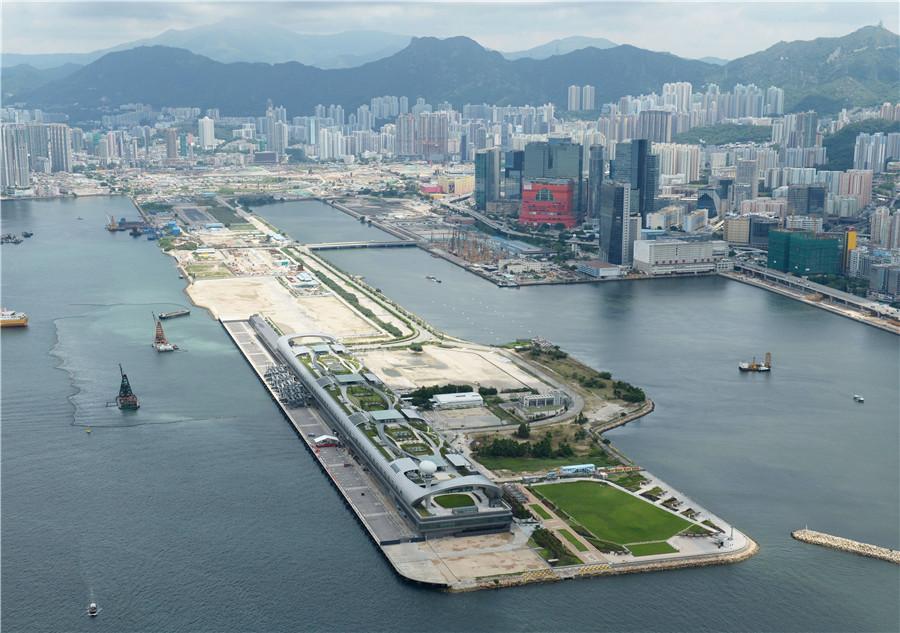
An aerial view of the Kai Tak Cruise Terminal. PHOTO PROVIDED TO CHINA DAILY
Challenges ahead
The Guangdong-Hong Kong-Macao Greater Bay Area will bring Chek Lap Kok unprecedented development opportunities. It also exposes the airport to a fiercely competitive market.
There are six airports in the Bay Area, the other five being Guangzhou Baiyun International Airport, Shenzhen International Airport, Zhuhai Airport and Foshan Shadi Airport in Guangdong, and Macao International Airport.
Research released in June last year found that Hong Kong was losing market share to its Bay Area counterparts on both international and domestic routes.
According to the Policy Research Institute of Global Supply Chain at Hang Seng Management College, the airports in Guangzhou and Shenzhen enjoyed 37 percent and 56 percent traffic growth respectively between 2011 and 2015.
The growth rates were far higher than the global average of less than 20 percent over the same four-year period. During this time, Hong Kong International Airport experienced traffic growth of 29 percent.
"If these two airports continue developing at this pace, they will surpass HKIA traffic in five to 10 years," the research report stated.
Wong Wai-hung, the principal researcher for the study, warned that Hong Kong could lose its leading role to Guangzhou Baiyun International Airport within three years.
Last year, Guangzhou Baiyun handled 65.83 million passengers, about 7.8 million fewer than Hong Kong. With its new terminal, which opened in April, the Guangzhou facility is expected to handle more than 70 million passengers this year, close to Hong Kong's current 73.6 million passenger volume.
Describing Guangzhou Baiyun as Hong Kong's biggest competitor, Wong said her view was based on the fact that Guangzhou has gradually become increasingly attractive as a transit hub.
She said that in 2011, Hong Kong handled 35 million transit passengers, 23 percent more than Guangzhou. Four years later, Guangzhou had started to close in, shrinking the gap to only 11 percent.
Meanwhile, the Guangzhou airport has introduced policies intended to capture passenger traffic from Hong Kong.
It allows transit passengers to skip immigration inspections if they are departing within 24 hours. A 72-hour transit visa exemption policy allows travelers from 51 countries and regions to visit other cities in Guangdong while waiting for connecting flights.
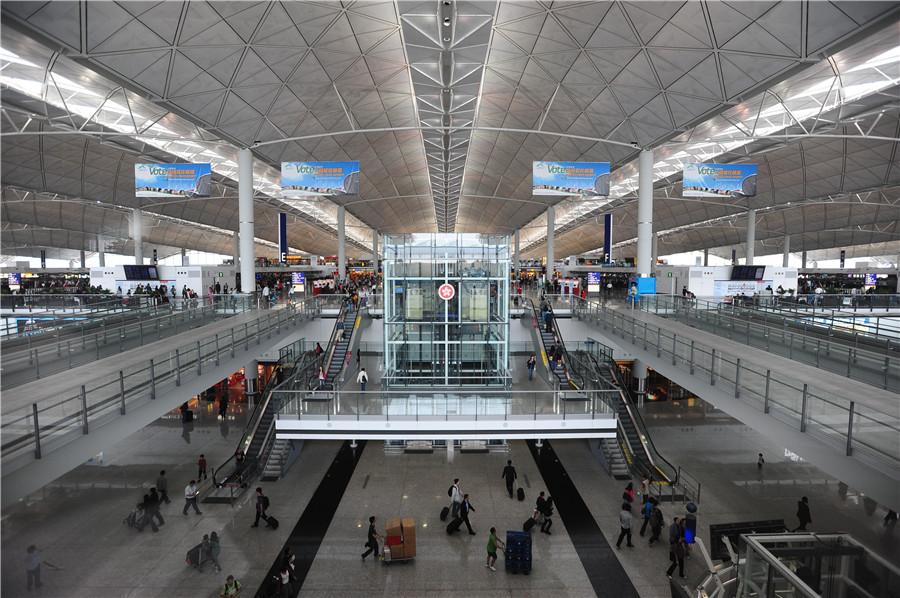
Hong Kong International Airport Terminal 1. PHOTO PROVIDED TO CHINA DAILY
There is considerable duplication of air services in Hong Kong and Guangzhou. Some 68 percent of Hong Kong airport's direct routes are also served by the Guangzhou facility.
The number of Asian airlines operating from both Hong Kong and Guangzhou increased from 18 in 2006 to 34 in 2016. The number of European airlines operating from both airports rose from four to seven over the 10 years.
Law Cheung-kwok, from the Chinese University of Hong Kong, who is director of policy at the Aviation Policy and Research Center, said another challenge facing Hong Kong airport it that it has nearly reached passenger capacity.
Before the third runway is completed in 2024, the airport's Pearl River Delta passenger volume will have dropped by 20 percent. And with the operation of a series of infrastructure projects, such as the Hong Kong-Zhuhai-Macao Bridge and the high-speed rail system connecting Guangzhou and Hong Kong, this reduced passenger volume will flow to other Bay Area airports, Law said.
But he is positive about the development of Chek Lap Kok, as both it and Guangzhou Baiyun have different market orientations, and these will remain for a long time.











